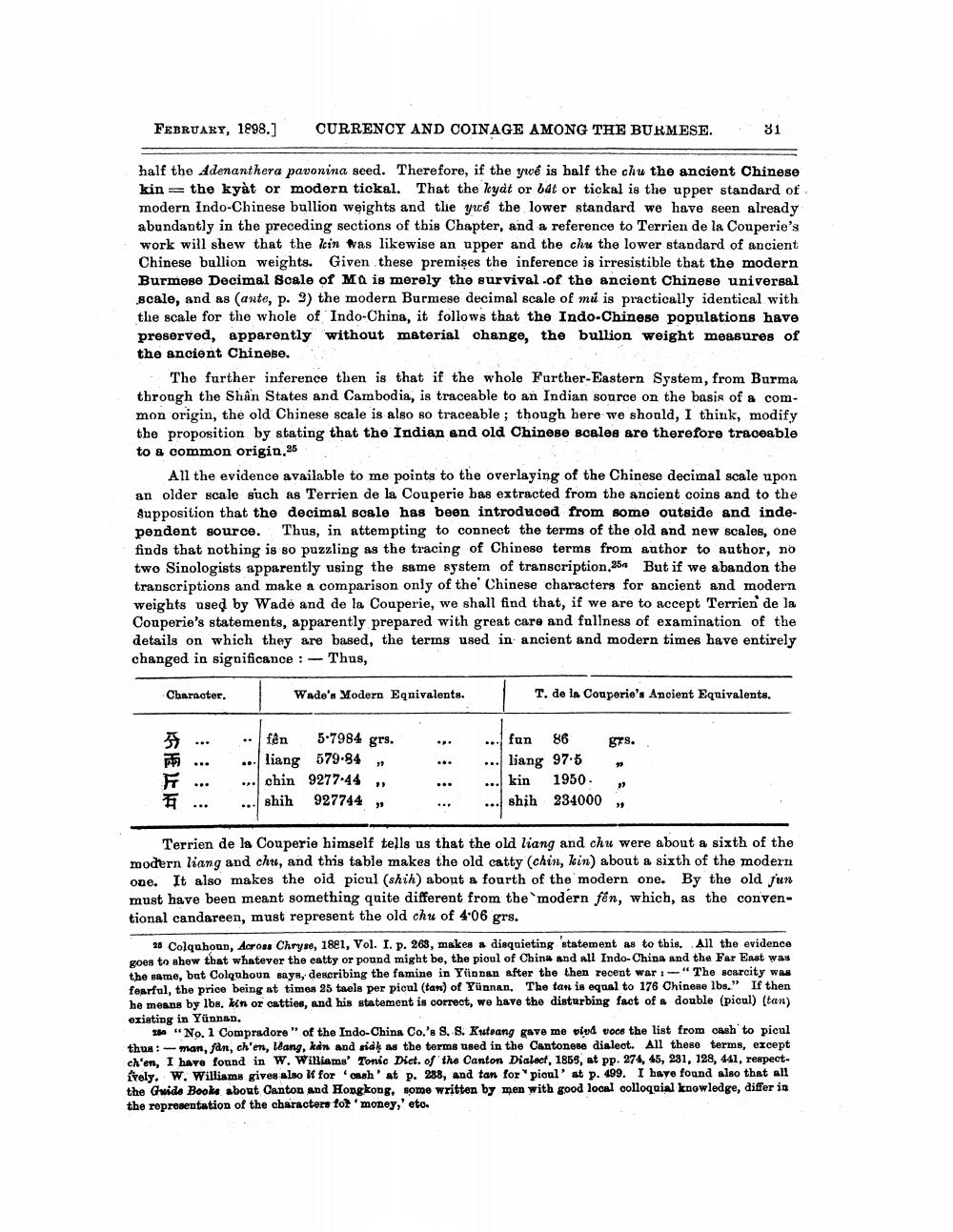________________
FEBRUARY, 1898.)
CURRENCY AND COINAGE AMONG THE BURMESE..31
half the Adenanthera pavonina seed. Therefore, if the ywe is half the chu the ancient Chinese kin = the kyàt or modern tickal. That the kydt or bat or tickal is the upper standard of modern Indo-Chinese bullion weights and the ywe the lower standard we have seen already abundantly in the preceding sections of this Chapter, and a reference to Terrien de la Couperie's work will shew that the Icin was likewise an upper and the chu the lower standard of ancient Chinese bullion weights. Given these premises the inference is irresistible that the modern Burmese Decimal Scale of MQ is merely the survival of the ancient Chinese universal scale, and as (ante, p. 9) the modern Burmese decimal scale of mu is practically identical with the scale for the whole of Indo-China, it follows that the Indo-Chinese populations have preserved, apparently without material change, the bullion weight measures of the ancient Chinese.
- The further inference then is that if the whole Further-Eastern System, from Burma tbrongh the Shân States and Cambodia, is traceable to an Indian source on the basis of a common origin, the old Chinese scale is also so traceable; though here we should, I think, modify the proposition by stating that the Indian and old Chinese scales are therefore traceable to & common origin.26
All the evidence available to me points to the overlaying of the Chinese decimal scale upon an older scale such as Terrien de la Couperie bas extracted from the ancient coins and to the Supposition that the decimal scale has been introduced from some outside and independent source. Thus, in attempting to connect the terms of the old and new scales, one finds that nothing is so puzzling as the tracing of Chinese terms from author to author, no two Sinologists apparently using the same system of transcription,250 But if we abandon the transcriptions and make a comparison only of the Chinese characters for ancient and modern weights used by Wade and de la Couperie, we shall find that, if we are to accept Terrien de la Couperie's statements, apparently prepared with great care and fullness of examination of the details on which they are based, the terms used in ancient and modern times have entirely changed in significance : - Thus,
Character.
Wade's Modern Equivalents.
T. de la Couperie's Ancient Equivalents.
fên ... liang ... chin ... shih
5-7984 grs. 579.84, 9277.44., 927744 »
fun 86 grs. ... liang 97.5 ... kin 1950. 1
shih 234000
...
Terrien de la Couperie himself tells us that the old liang and chu were about a sixth of the modern liang and chut, and this table makes the old catty (chin, kein) about a sixth of the modern one. It also makes the old picul (shih) about a fourth of the modern one. By the old fun must have been meant something quite different from the modern fén, which, as the conventional candareen, must represent the old chu of 4:06 grs.
25 Colquhoun, Across Chryse, 1881, Vol. I. p. 268, makes a disquieting statement as to this. All the evidence goes to show that whatever the eatty or pound might be, the pioul of China and all Indo-China and the Far East was the same, but Colquhoun says, describing the famine in Yiinnan after the then recent war: -" The sourcity was fearful, the price being at times 25 taols per picul (tan) of Yunnan, The tan is equal to 176 Chinese lbs." If then he means by lbs, kin or catties, and his statement is correct, we have the disturbing fact of s double (picul) (tan) existing in Yünnan.
"No. 1 Compradore" of the Indo-China Co.'s S. S. K14eang gave me vivd voce the list from ouch to picul thus:- man, fan, ch'en, lang, kein and ride as the terms used in the Cantonese dialect. All these terms, except ch'en, I have found in W. Williams' Tonic Dict. of the Canton Dialect, 1858, at pp. 274, 45, 231, 128, 441, respectively. W. Williams gives also for onsh' at p. 288, and tan for pioul' at p. 499. I have found also that all the Guido Booke about Canton and Hongkong, some written by men with good local colloquial knowledge, differ in the representation of the characters tot 'money,' eto.




